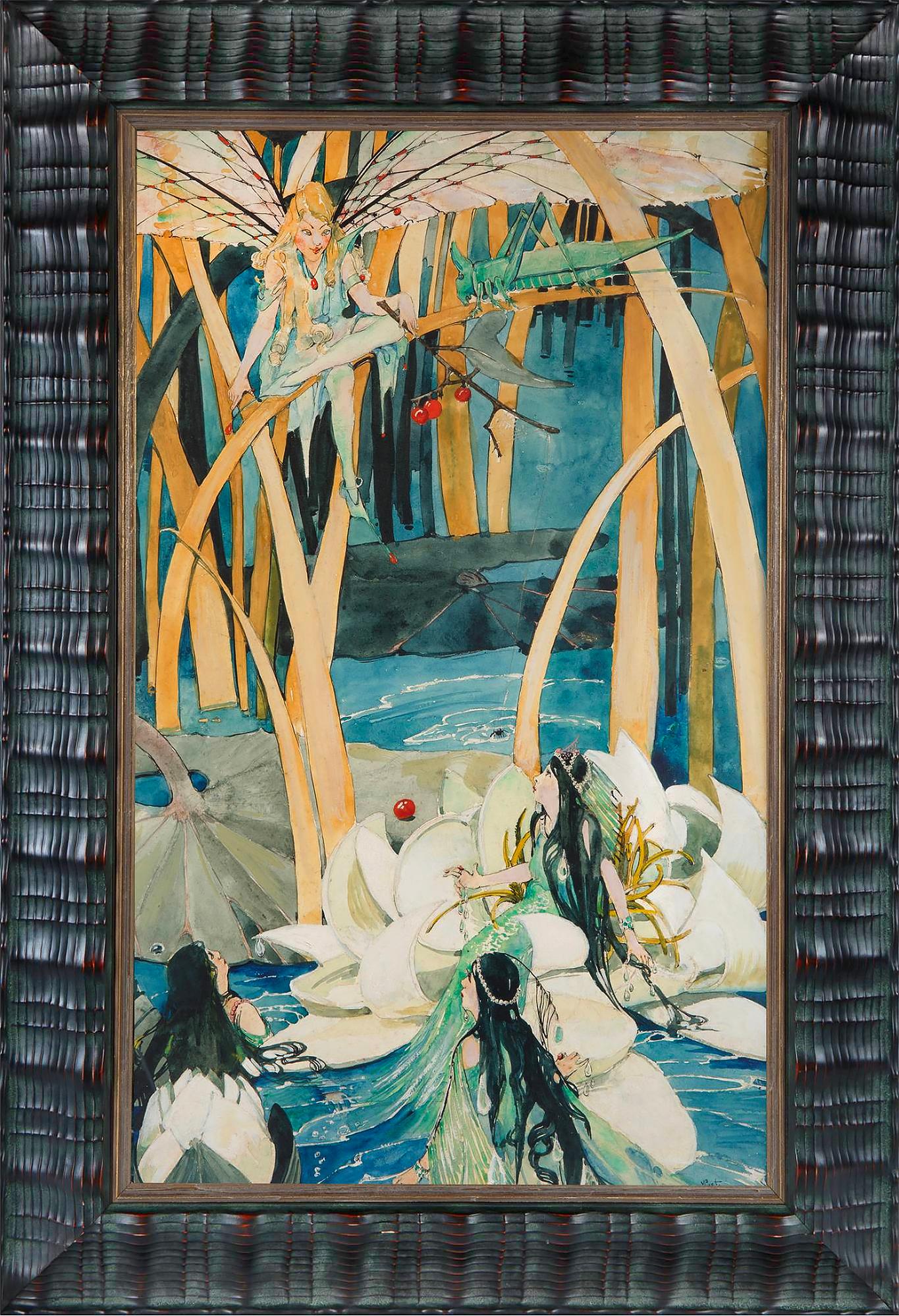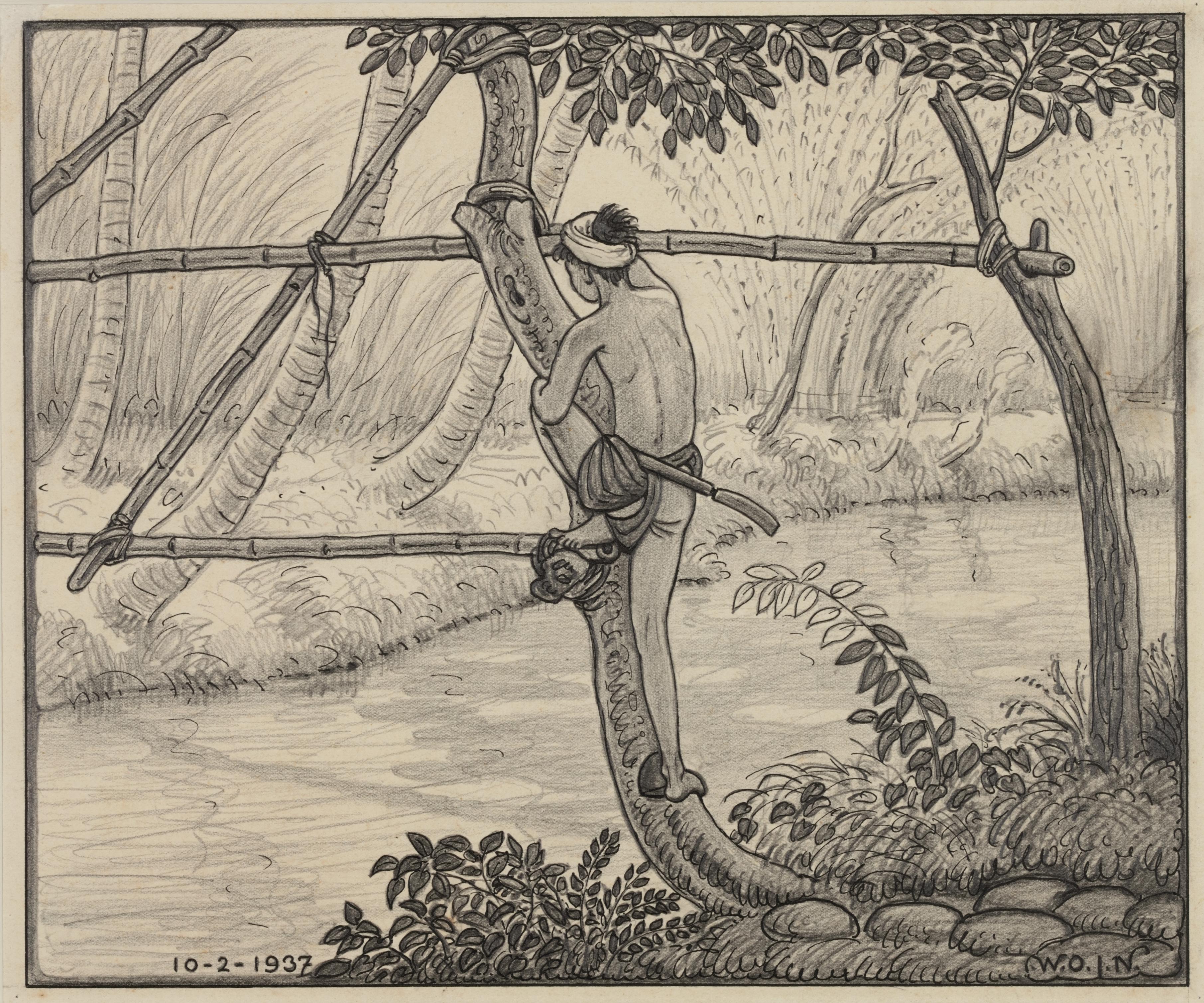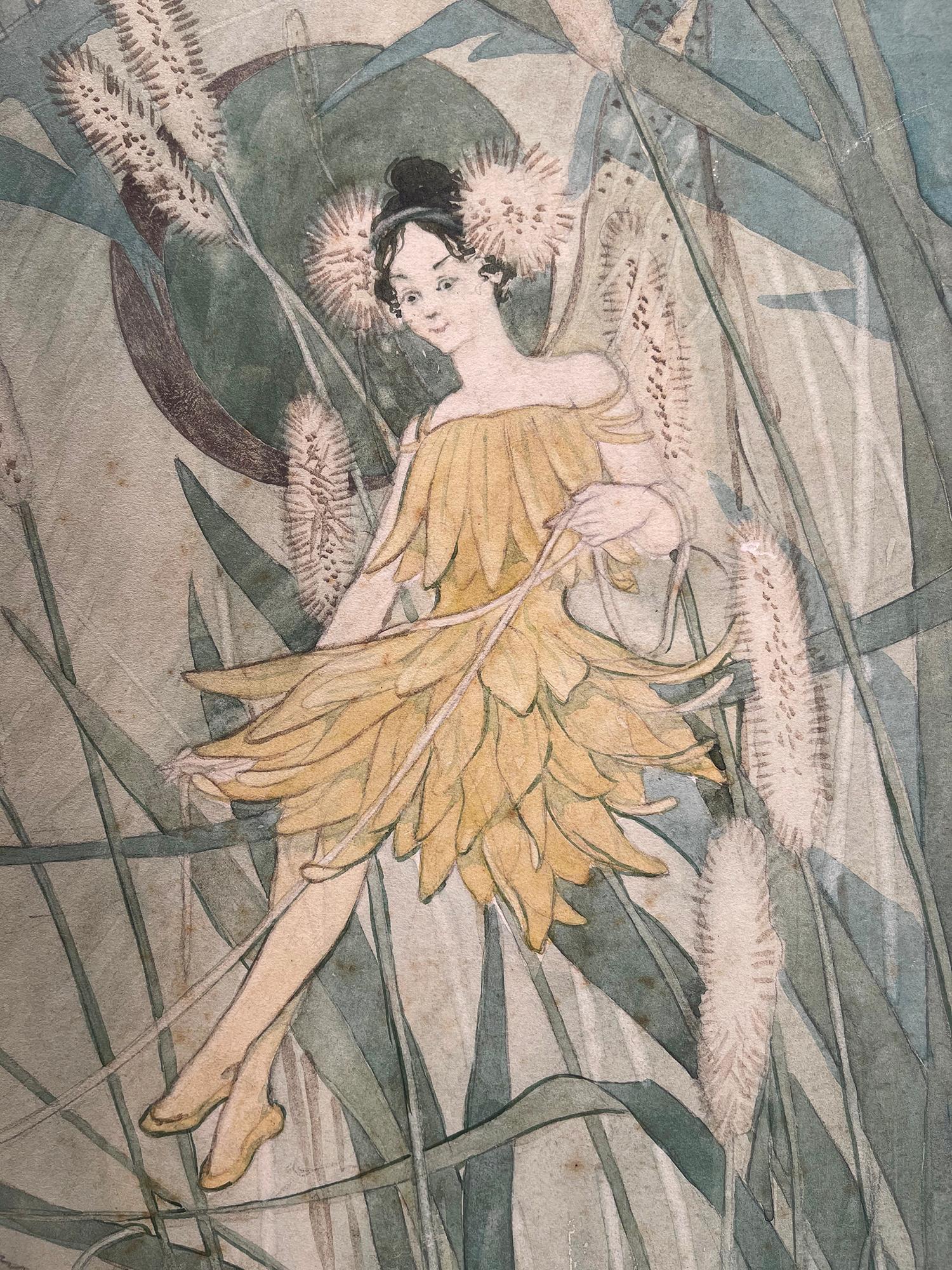Items Similar to "Medieval Thoughts, Prague, " Alphonse Mucha, Czech Art Nouveau Illustration
Want more images or videos?
Request additional images or videos from the seller
1 of 13
Alphonse Mucha"Medieval Thoughts, Prague, " Alphonse Mucha, Czech Art Nouveau Illustrationcirca 1890
circa 1890
About the Item
Alphonse Mucha (Czech, 1860 - 1939)
Medieval Thoughts, circa 1890
Wash, ink, and watercolor on paper
11 x 9 inches
Signed lower right
Provenance:
Phillips New York, 19th and 20th century American & European Paintings and Sculpture with American Illustrations, October 2, 1985, Lot 253
Howard and Merle Melton
Melton Art Reference Library, Oklahoma City
Exhibited:
Oklahoma City, Oklahoma Museums Association, 1988.
Oklahoma City Art Museum, The Paris of la Boheme: Paintings, Drawings, and Prints from the Late 19th and Early 20th Centuries, February - March, 1996.
Shawnee, Oklahoma, Mabee-Gerrer Museum of Art, September - October, 1996.
Stillwater, Oklahoma, Oklahoma State University, February - March 1998.
A painter, illustrator and muralist whose name is prominently associated with Art Nouveau, Alphonse Mucha created work with strong composition and color and sensuous curves derived from nature. Using this style, he began earning widespread attention in the 1890s for his illustration work including posters of actress Sarah Bernhardt.
Although his name is linked to Art Nouveau, a style meaning 'new art' in French, he avoided that discussion by saying he was merely painting in a way that was unique and natural to him. Alphonse Mucha was born in 1860 in Ivancice, Moravia, which is near the city of Brno in the modern Czech Republic. When he finished high school, he became determined to become a painter, despite his father's efforts in securing him "respectable" employment as a clerk in the local court.
Mucha went to Paris in 1887, thanks to a patron in Moravia who paid for his studies. After two years in Munich and some time devoted to painting murals for his patron, he went to Paris where he studied at the Academie Julian. After two years the patron stopped supporting him, and Alphonse Mucha was a 27 year old with no money and seemingly little future in Paris.
For five years he lived the 'Bohemian' lifestyle of a struggling artist. He borrowed money, got a few low-paying commissions for artwork, and became deathly ill from an unhealthy diet. For a period he shared a studio with Paul Gauguin and traveled to the South Seas. He also gave a few art lessons and strove to find his own unique style in an era dominated by the new styles of Impressionism and Symbolism.
Beginning 1895, he presented his revolutionary approach to poster stylistic design, which was flowing lines and soft colors as opposed to traditional bright colors and sharp, geometric delineation. Commissioned in December 1895 to create a poster for Sarah Bernhardt's play, Gismonda, he did a near life-size image of her that was a design sensation. Pleased with Mucha's work, Bernhardt signed him to a six-year contract to design her promotional posters.
From that time, his reputation and financial success were insured. By 1898, he had a new studio, had his first one-man show and had numerous illustration commissions. He worked with a printmaker, who enthusiastically promoted his postcards, posters, etc.
In 1900, Mucha designed the Bosnia-Herzegovina Pavilion for the Paris World's Fair and also partnered with goldsmith Georges Fouquet in jewelry design. He published writing with accompanying illustrations about his art theories, and many took advantage of these visuals by copying his style.
His popularity and increasing name association with Art Nouveau led to international travel including several extended trips to the United States where he did magazine illustration work, portrait commissions and teaching. In the spring of 1904, he made his first trip to America, visiting New York, Philadelphia, Boston and Chicago, and the next year he had one-man exhibition tours of New York, Philadelphia, Chicago and Boston. In 1907, he married Maruska Chytilová in Prague, and he and his wife went to America where he gave art lessons in New York, Chicago and Philadelphia, and in 1908 filled a decoration commission for the new German Theatre in New York. In 1909, the couple's daughter, Jaroslava, was born in New York City.
However, Alphonse Mucha ever remained the committed citizen of his homeland of Czechoslovakia, and did a series of murals for the Lord Mayor's Hall in Prague and also a series of paintings of the country's history, The Slav Epic, financed by Charles Crane, a wealthy man from Chicago whom he had met in 1904 through introduction by Baroness Rothchild. This project, a gift to the city of Prague, took eighteen years to complete and was composed of twenty paintings on canvas, each about 24 x 30 feet. In 1919, the paintings were also exhibited in America, where it was said they were more warmly received than in their homeland. Before returning to Prague, that year, Mucha spent time as a teacher at the New York School of Applied Design for Women* and was included in the American Art Annual, the predecessor to Who's Who in American Art.
The life of Alphonse Mucha, like so many Europeans and Americans of his era, was greatly affected by the World Wars. When Czechoslovakia was invaded by the Germans at the beginning of World War II, he was one of the first citizens arrested because of his strong nationalistic expressions. He died on July 14, 1939, shortly after being released from intense Gestapo questioning.
- Creator:Alphonse Mucha (1860 - 1930, Czech)
- Creation Year:circa 1890
- Dimensions:Height: 16 in (40.64 cm)Width: 12 in (30.48 cm)
- Medium:
- Movement & Style:
- Period:
- Condition:Excellent.
- Gallery Location:New York, NY
- Reference Number:1stDibs: LU184129904512
About the Seller
5.0
Platinum Seller
These expertly vetted sellers are 1stDibs' most experienced sellers and are rated highest by our customers.
Established in 2021
1stDibs seller since 2022
60 sales on 1stDibs
Typical response time: 1 hour
- ShippingRetrieving quote...Ships From: New York, NY
- Return PolicyA return for this item may be initiated within 3 days of delivery.
More From This SellerView All
- "Street Fair” William Glackens, Ashcan School, Street Scene, Carnival, BoxingBy William GlackensLocated in New York, NYWilliam Glackens Street Fair, circa 1905 Pencil, ink and gouache on paper 10 x 14 inches Provenance: The artist Kraushaar Galleries, New York Estate ...Category
Early 1900s Ashcan School Landscape Drawings and Watercolors
MaterialsGouache, Pencil, Paper, Ink
- Out of the Sun (Under the Racetrack Grandstand), Saratoga Springs, Anne DiggoryBy Anne DiggoryLocated in New York, NYAnne Diggory (b. 1951) Out of the Sun (Under the Racetrack Grandstand), 1978 Watercolor on paper 7 x 10 inches Signed and dated lower left Provenance: Ac...Category
1970s Contemporary Landscape Drawings and Watercolors
MaterialsPaper, Watercolor, Pencil
- "Sleigh Ride, Winter, " Fletcher Martin, Woodstock, Holiday Scene IllustrationBy Fletcher MartinLocated in New York, NYFletcher Martin (1904 - 1979) Sleigh Ride, Woodstock, New York circa 1955 Watercolor on paper 14 x 11 inches Signed lower right Provenance: James Cox Galler...Category
1950s American Realist Landscape Drawings and Watercolors
MaterialsPaper, Watercolor
- Five at the Rail, View of Racetrack and Crowd, Saratoga Springs, New YorkBy Anne DiggoryLocated in New York, NYAnne Diggory (b. 1951) Five at the Rail, Saratoga Springs Racecourse, New York, circa 1978 Watercolor on paper 4 3/4 x 6 inches Initialed lower right: Dig...Category
1970s Contemporary Landscape Drawings and Watercolors
MaterialsWatercolor, Paper
- "Untitled, " Crash, Pop Art, Street Art Graffiti, Figure with ClockBy John Crash MatosLocated in New York, NYCrash Untitled, 1989 Signed and dated lower left Watercolor and ink on paper 30 x 20 1/2 inches A contemporary of Keith Haring and a modern-day master of this present day art form o...Category
1980s Street Art Figurative Paintings
MaterialsPaper, Ink, Watercolor
- "Pleased to See You, " Crash, Pop Art, Street Art GraffitiBy John Crash MatosLocated in New York, NYCrash Pleased to See You, 1989 Signed and dated lower left Watercolor and ink on paper 30 x 20 1/2 inches A contemporary of Keith Haring and a modern-day master of this present day ...Category
1980s Street Art Figurative Paintings
MaterialsInk, Watercolor, Paper
You May Also Like
- Fairies among the Lily Pads - Female Illustrator FantasyLocated in Miami, FLA turn-of-the-century fantasy illustration by female illustrator May Audubon Post features a charming fairy with expanded wings resting on Lilly s...Category
Early 1900s Art Nouveau Figurative Drawings and Watercolors
MaterialsPaper, Ink, Watercolor
- Borobudur, Java, Indonesia (1937)Located in Amsterdam, NLGraveyard with in the background the Borobudur, 1937 Signed with initials and dated bottom left Pencil and ink on paper, 33 x 29 cm In ebonized frame with white mount Literature: ...Category
1930s Art Nouveau Landscape Drawings and Watercolors
MaterialsPaper, Ink, Graphite
- Wobbly bridge, Tabanan, Bali, 1937Located in Amsterdam, NLWobbly bridge, Tabanan, Bali, 1937 Signed with initials bottom right and dated, bottom left Pencil and ink on paper, 22 x 26.3 cm In ebonized frame with white mount Willem Otto Wi...Category
1930s Art Nouveau Landscape Drawings and Watercolors
MaterialsIndia Ink, Paper, Pencil
- Beach of Kusambe, Bali 1937Located in Amsterdam, NLFour outrigger proa’s on the beach of Kusambe, Bali, 1937 Signed with initials, dated and described with location bottom left Pencil and ink on paper, 29.7 x 35 cm In ebonized frame with white mount WILLEM OTTO WIJNAND NIEUWENKAMP (1874-1950) Nieuwenkamp was born on July 27th 1874 in Amsterdam. His father owned sailing ships sailing to Indonesia and hearing the stories of the returning captains evoked in the young Nieuwenkamp an obsession for distant lands and adventure. After a failed attempt by his father to have his son make a career in his business, Nieuwenkamp attended the Academy for Decorative Art in Amsterdam. However, he left within one year to go his own way. He was an autodidact and a great experimenter with new techniques, particularly in the art of etching. Nieuwenkamp was a very focused man with the discipline of a scientist tempered by the sensitivity of an artist, a lust for adventure, a natural appreciation for ethnic arts and an enormous ambition to tread new paths. In 1898 he visited Indonesia for the first time and on his second visit in 1903-1904 he went on to Bali and became the first foreign artist to love Bali and the Balinese with a passion. Having secured agreements with several museums in the Netherlands to obtain Balinese art and objects for their collections, Nieuwenkamp immediately started to purchase and order a wide range of ethnographic art and objects from local artists and craftsmen. Through his drawings and books, he gave an excellent impression of Balinese art and culture at that time. Since 1854 Northern Bali was under Dutch...Category
1930s Art Nouveau Landscape Drawings and Watercolors
MaterialsIndia Ink, Paper, Pencil
- Statue of Vishnu Garuda, Bali, 1904Located in Amsterdam, NLStatue of Vishnu Garuda, Bali, 1904 Signed with initials Pencil and ink on paper, 21.4 x 21.3 cm Literature: Bruce W. Carpenter, W.O.J. Nieuwenkamp. First European Artist in Bali,...Category
Early 1900s Art Nouveau Landscape Drawings and Watercolors
MaterialsPencil, Paper, India Ink
- Fairy in the Pussy Willows with Baby and Spider Web Fantasy Children's BookLocated in Miami, FLThis work is presented more as a concept piece since it's condition is destresed. Illustrator Hazel Frazee was a Female Illustrator in the first quarter of the 20th century for child...Category
1920s Art Nouveau Landscape Drawings and Watercolors
MaterialsPencil, Watercolor
Recently Viewed
View AllMore Ways To Browse
Illustration Art Signed
American Illustration
American Illustration Art
Antique Illustrations
Paris Illustration
Illustration Artwork
Art Nouveau 1890
Paris Art Nouveau
Art Nouveau Framed
Revolutionary Art
American Art Nouveau
Antique Medieval
Medieval Antique
By Prague
Dior Illustration
Czech Artist
Antique Art Gift
Art Painting Nouveau





